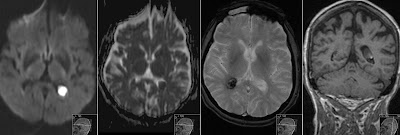Non-Ketotic Hyperglycemic Hemichorea - Diabetic Striatopathy
Non-Ketotic Hyperglycemic Hemichorea (NKHH), also known as Diabetic Striatopathy, is a rare neurological disorder predominantly observed in patients (mostly Asian elderly women) with uncontrolled diabetes, usually type 2. It is characterized by involuntary, irregular, and unpredictable movements, primarily affecting one side of the body (hemichorea). The condition is linked to hyperglycemia without ketosis and often involves alterations in the basal ganglia's striatum (comprising the caudate nucleus and putamen).
A 49-year-old Caucasian male with a history of type 1 diabetes presented with characteristic symptoms of hemichorea. This case is particularly noteworthy given the patient's background, as NKHH predominantly affects older individuals with type 2 diabetes.
Radiological Findings: CT and MRI Analysis
Image 1: Initial CT and MRI
The first CT scan, performed without contrast, revealed diffusely increased signal intensity in the putamen, more pronounced on the right. The subsequent MRI, conducted without contrast, showed elevated T1 signal intensity in the posterior part of the right putamen, likely indicating methemoglobin presence. Accompanying these findings were slight edema around the right putamen and minimal diffusion restriction.
Image 2: One-Year Follow-Up MRI
A follow-up study conducted a year later (top row) presented a remarkable resolution of the condition. Comparison with the original MRI (bottom row) highlighted the resolution of edema and the emergence of low signal in the right putamen on Susceptibility Weighted Imaging (SWI), suggestive of hemosiderin deposition (most right top row).
Images 3 and 4: Additional Sequence Comparisons
Further comparative sequences reinforced the initial observations and provided a comprehensive view of the patient's response to treatment.
Key Insights and Take-Home Message
This case underscores the importance of meticulous radiological examination in patients presenting with hemichorea, particularly in those with a history of diabetes. The distinct radiological feature to note is the diffusely increased density in the putamen on CT scans, which may not present as an obvious hemorrhage. Early recognition of these signs, coupled with the specific clinical history, can prompt a suspicion of Diabetic Striatopathy, facilitating timely intervention and management.






